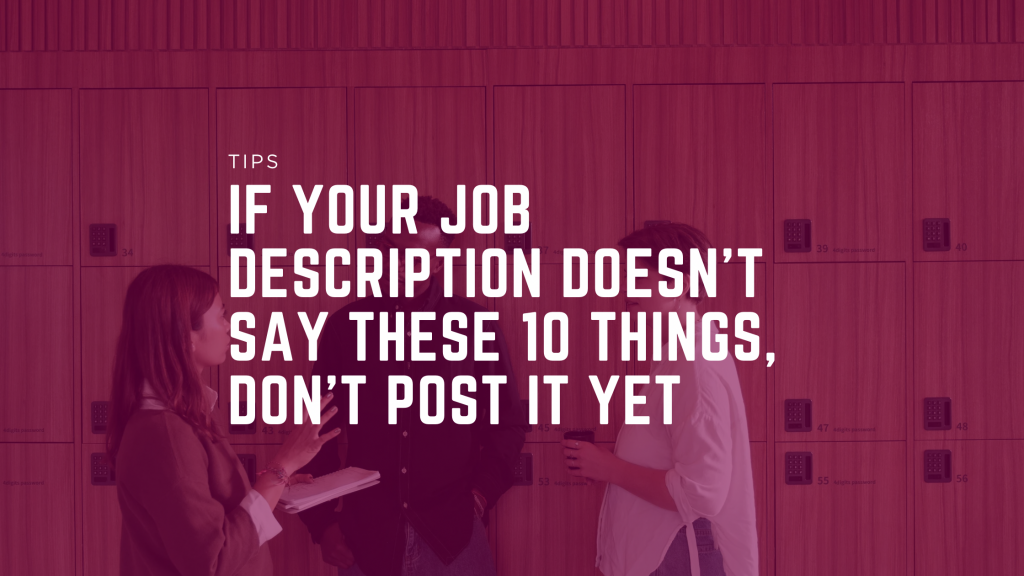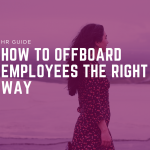Writing a job ad isn’t just about finding the right person. It’s about showing that you know what you’re hiring for.
Disclaimer: This approach won’t be for everyone, but if you’re tired of wasting time on job ads that attract the wrong people, start here.
Companies are flooded with applications right now, but let’s be honest: more doesn’t always mean better. High volume doesn’t guarantee high quality. And whether you’re getting hundreds of applicants or struggling to attract a handful, your job ad does more than list responsibilities: It shows how your company thinks, operates, and communicates.
In a market full of recycled, vague, and copy-paste job ads, a clear, structured, and honest job description helps you stand out. It’s your first impression, your first filter, and the first experience someone has with your company.
And here’s what often gets overlooked: writing a good job ad doesn’t just help candidates. It helps you. It forces clarity about the role, your team, and the offer you’re actually putting on the table.
So instead of asking, “What do we want from a candidate?”, start with, “What would make someone feel this job respects their time and effort?”
This post walks you through the 10 questions every job ad should answer, so you communicate with more intent, and make hiring a little less chaotic.
1. Where will I actually work?
This might sound a bit profane, but clarity around location shouldn’t be neglected. It’s not just about geography, it’s about structure and whether the setup works for someone’s real life. Remote options, working hours, and whether someone can see themselves in the role all depend on this. Or worse, it leads to mismatched expectations.
If you’re fully on-site, hybrid with structure, or remote with flexibility you have to spell it out. The more clearly you describe how your team actually works, the more confident someone can be about whether they’d thrive there. And please, don’t lie about it. If you don’t offer hybrid or flexible hours, say that explicitly.
A vague “flexible working options available” sounds nice on paper, but tells people nothing. Does that mean one remote day, a compressed week, or a vague promise that’s ‘flexible’ only when your manager’s in the right mood. Be specific.
Try something like:
“We work from our Collingwood office three days a week, with Mondays and Fridays remote. Most of the team starts around 9 and wraps by 5:30, with flexibility around school pickups.”
That kind of clarity helps people self-select and builds trust. It says you’ve thought about how work fits into life and not just the other way around.
2. What’s the working environment like?
This is where most job ads start making something up. A vague “great culture” doesn’t build trust. It builds doubt. And for people who’ve had bad experiences before, those generic lines are red flags. Working environment means: how people interact, how decisions are made, how feedback happens, and whether people feel safe to speak up. It’s not about shiny values on your website. It’s about behaviours. It’s about what someone will actually feel in their first week.
Don’t be afraid to be honest. If your team thrives on structure and daily standups, say it. If everyone’s heads-down and async-first, say that too. There’s no perfect vibe, just the one that works for your team.
Try something like:
“We work in small squads that run their own projects. We meet twice a week for syncs, share async updates via Notion, and give regular feedback in 1:1s. Managers are there for support, not sign-offs. We care about clarity, not chaos.”
3. What will I actually do all day?
I probably won’t break it to you, but people aren’t applying to join your vision. They’re applying to do a job. And if your ad is full of generic goals and tasks without the daily reality, they’ll very likely make wrong assumptions about it. The main purpose here is to inform through detailed, real-life insight.
Think about it like this: What will someone actually be doing between 9 and 5? Are they writing, coordinating, fixing, calling, building? Clarity here shows that you’ve thought the role through and helps people picture themselves in the job (or rule it out early, which is a win, too).
Be specific.
Instead of: “You’ll support the team.”
Try: “You’ll coordinate calendars, prep documents, and manage inbox queries for the operations manager.”
That’s what people need to know to make a real decision.
Or:
“You’ll write and schedule 2 newsletters per week in Mailchimp, manage a weekly client campaign, and present performance updates in a fortnightly team huddle.
4. What’s the salary (or range)?
Let’s be real: it’s 2025, and salary secrecy is no longer a power move, more it’s a credibility killer. People want to know upfront if the role works for their life and skipping this question doesn’t create mystery, but it creates mistrust.
Salary isn’t just about numbers. It’s about transparency, alignment, and respect. If you’re clear about the range, what’s negotiable, and what’s tied to the offer (super, bonuses, allowances), you’re giving people the chance to make informed decisions.
And if you’re worried about internal equity or people negotiating differently—leaving the salary out won’t fix that. Sorting your pay structure will.
Don’t write: “We offer a competitive salary.” It says nothing, means nothing, and makes people assume you’re hiding something.
Instead try this:
“The base salary is $78,000–$85,000 plus super, depending on experience. We’re open to negotiation for the right candidate.”
5. What benefits or perks will I receive?
What value do you offer? Fun team events and free snacks were never real benefits. What people care about today is whether you support their wellbeing, growth, and real life outside of work. So, this is where your company shows what kind of employer it actually is. If you offer wellness days, learning budgets, flexible hours, DEI programs, or actual psychological safety, you should list it — and explain how.
The more specific you are, the more believable it feels. That’s how benefits go from fluffy to meaningful.
Don’t write: “We offer great perks including fun team events and snacks.”
It’s empty, and it sounds like you’re trying to dress up your benefits..
Try this instead: “You’ll have access to 5 wellness days a year, a $1,000 annual learning budget, and a hybrid setup with core hours flexibility. We also run monthly DEI circles and offer free professional counselling for all staff.”
6. What’s the application process like?”
The hiring process shouldn’t feel like a test of how long someone can wait without hearing back. If you want people to take your company seriously, start by showing that you do too.
Let them know upfront how long things will take, how many steps there are, and what’s involved. A clear process sets expectations and builds trust before a single interview even starts.
Don’t write:
“We’ll be in touch if you’re shortlisted.”
It’s vague, passive, and makes your company look unprepared.
Try this instead:
“You’ll hear back within 3 business days. The process includes a 30-minute intro call, a short task, and a final panel interview with the team. The whole process takes about 2–3 weeks.”
A side note: If you write it in the job ad, you better deliver. That includes the timeline, tone, and structure of your application process.
7. How do I actually apply?
When candidates don’t know how to apply, you lose them before they even consider it.
Provide a listing of what to submit, whether a portfolio or a short note is needed, and where to send it. If there’s a deadline, include it. If there’s a non-negotiable, name it.
Don’t write: “Send your application to hr@company.com.”
It looks like you copy-pasted this from a template and that’s how people will treat the role.
Try this instead:
“Please send your CV and portfolio (PDF or website) to careers@company.com by 12th July. No cover letter needed, just include a short note (3–5 sentences) on why this role interests you.”
8. Who is my contact person?
The least you can do is show that there’s a human on the other side. Name the person managing the process. Add their role. And if possible, include a short note or intro from them. It adds warmth and makes it easier for candidates to ask relevant questions early.
Instead of: “For further information, contact the team.” (It’s vague, corporate, and makes the whole process feel faceless.)
Try this instead:
“You’ll be speaking with Maya, our Talent Partner for this role. She’s happy to answer any questions before you apply.”
This kind of clarity turns your process from transactional to relational. It says: we see you, and we’ll treat you like a person not a number.
9. What skills or experience do I really need?
This section is not a 20-point wishlist. A long list doesn’t impress anyone and rather confuses people. Are you looking for a pink unicorn with the strength of a gorilla? Think again. So, what matters is what someone has to bring, and what they can learn once they’re in the role with you.
If the person needs to hit the ground running with a tool, say so. If something’s coachable, say that too. Being transparent here helps capable people apply, even if they’re not a 100% match on paper.
Don’t write:
“Must have 5+ years of experience in a fast-paced environment, with strong leadership, collaboration, and time-management skills.”
That reads like you didn’t think through what success in this role actually looks like.
Try this instead:
“We’re looking for someone with solid project coordination experience (around 2–3 years is great), and confident using tools like Asana or Trello. You don’t need to have led a team yet, but you should feel comfortable managing timelines and talking to stakeholders.”
That’s what helps people assess themselves honestly, and apply with intention.
10. Why should I apply to this company?
If your only answer is “because we’re great” without substance, congrats, you’ve got a long way to go. If you’re not sure what makes you great, take a closer look at your leadership approach, your growth mindset, your commitment to sustainability, or your ability to give people real autonomy without the chaos. But be careful, it has to be real.
Think about what makes people stay? What do they say after joining that they didn’t expect?
Don’t write:
“We’re a great place to work with exciting opportunities and a supportive team.”
That sounds like a copy-paste from 2008 and no one believes it anyway.
Try this instead:
“We’re a small, stable team that values thoughtful work and clear communication. You’ll get focused time to grow your skills, regular 1:1s with your manager, and space to propose new ideas.”
That’s the kind of clarity that builds trust and makes people think, I’d like to work there.
But why put in the effort, what’s In It for You
Yes, I get it: this sounds like a lot of work for something that still might flood your inbox with applications that don’t fit. So why bother putting all this effort into a job ad?
Because the job ad isn’t just about who applies. It’s about how you hire, what you stand for, and what kind of experience you’re creating from day one.
- It helps you screen smarter: The clearer your ad, the easier it is to spot alignment and make confident decisions.
- It aligns your internal team: A good job ad forces clarity on what the role really is before you even start interviewing.
- It sets expectations early: You avoid surprises later by being upfront about what the job involves and what you offer.
- It shows your brand, not just your needs: Candidates don’t just read job ads, they judge the company behind them.
- It builds trust before the first contact: Transparency, tone, and structure all signal how you operate.
So no, it won’t magically filter out mismatches and let the perfect candidate appear. But it will make the rest of your process stronger, faster, and a lot more human.


